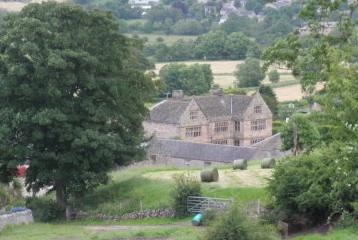The Herlings, the
Milwards and the Shaws
The exact connection between the Herling and the
Milward families (later more likely to be spelled Millward or sometimes
Millwood) is unknown but there clearly was one.
The earliest traced Herling definitely connected with the
Shaw family was James Milward Herling, born in 1837. He was an army
man and had at least nine children who were all born in
garrison towns in England and overseas, wherever he was in the army were at the
time. All of his children were given
the middle name of Milward and in some cases "Milward Herling" seems
to have been treated as their surname, occasionally it was
hyphenated. One of his sons, George Milward
Herling married Mary Jane Shaw.
John Milward was a civil war army colonel who lived
at Snitterton Hall which he had built in 1631, only half a mile from Oker
Hill (using sandstone from Oker). This is the hall recently:

In 1596 the original manor house on the site was
bought by John Shore of Darley for 400 pounds, his family sold it in
1627 to Thomas and Isaac Smith who sold it again to John Milward.
John Shore might well be related to the Shaws on this website but
there is no evidence yet.
John Milward was an investor in lead mines, the main industry
of the area in which many of the Shaws worked and from 1638 to 1661
was one of the Chief Barmasters for the industry in the Wirksworth
Wapentake. This was a role also known as the King's Farmer, designed
to oversee the industry and protect the taxes collected from it. The
monarch traditionally claimed all mineral rights at that time.
John Milward fought for King Charles I against Oliver Cromwell in the English civil
war and died in 1670. For a while he was a Member of Parliament and the
High Sheriff of Derbyshire. One of his sons (Captain) Henry Milward was also a
soldier and took over the estate but he died in 1681 during the
reign of Charles II. A grandson called
George inherited the estate but he died in 1711 and from then on the hall was no
longer owned by the Milward family.
The ancient parish church of St Helens in Darley
Dale contains a monument to John Milward, his wife and their eleven
children whose home was two miles away. That was the same church
that was
used by Mary Jane Shaw's family, her father John Shaw and many Shaw ancestors
who were baptised, married and buried
there.
Perhaps this shared geographical origin is what connected Mary
Jane Shaw to George Milward Herling. Clearly the Shaws were not in
the same social position as enjoyed by John Milward in the 17th century
- but two
hundred years later the Milward assets and their legacy had been dissipated.
The Diary of John Milward, Esq.,
Member of Parliament for Derbyshire September 17th 1666 to May 8th
1668 was edited by Caroline Robbins and published by Cambridge
University Press in 1938.



The contents of this site are copyright © 2021, Ken Herlingshaw.
Photograph of Snitterton Hall copyright of the owner.
|



